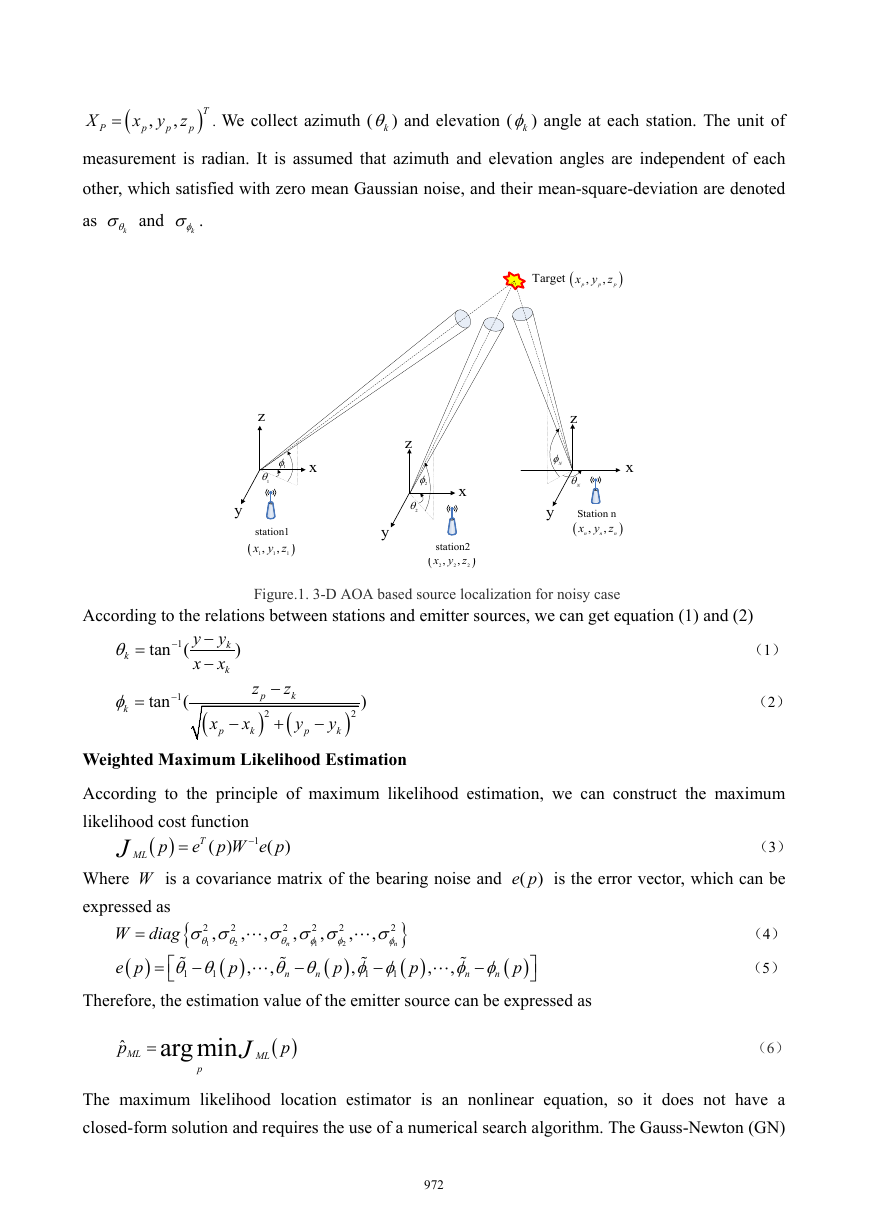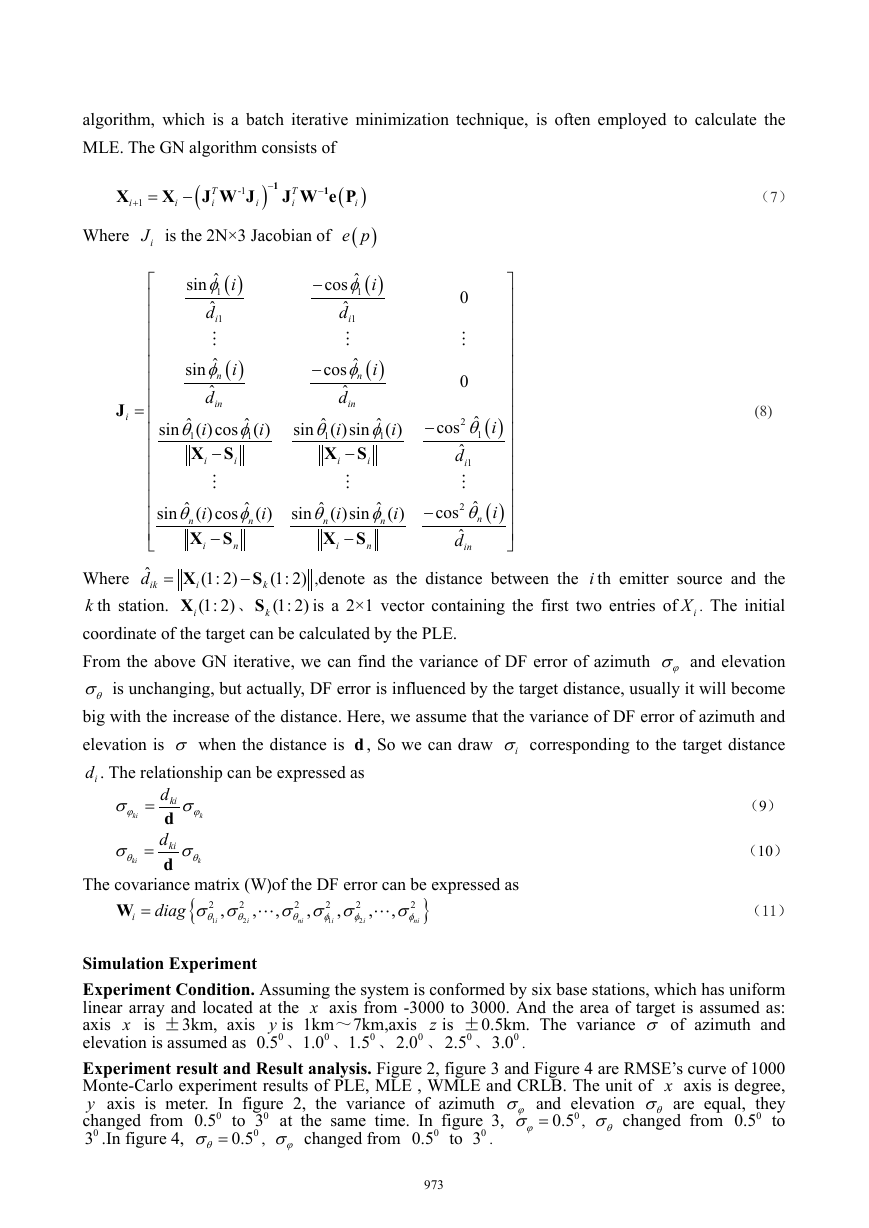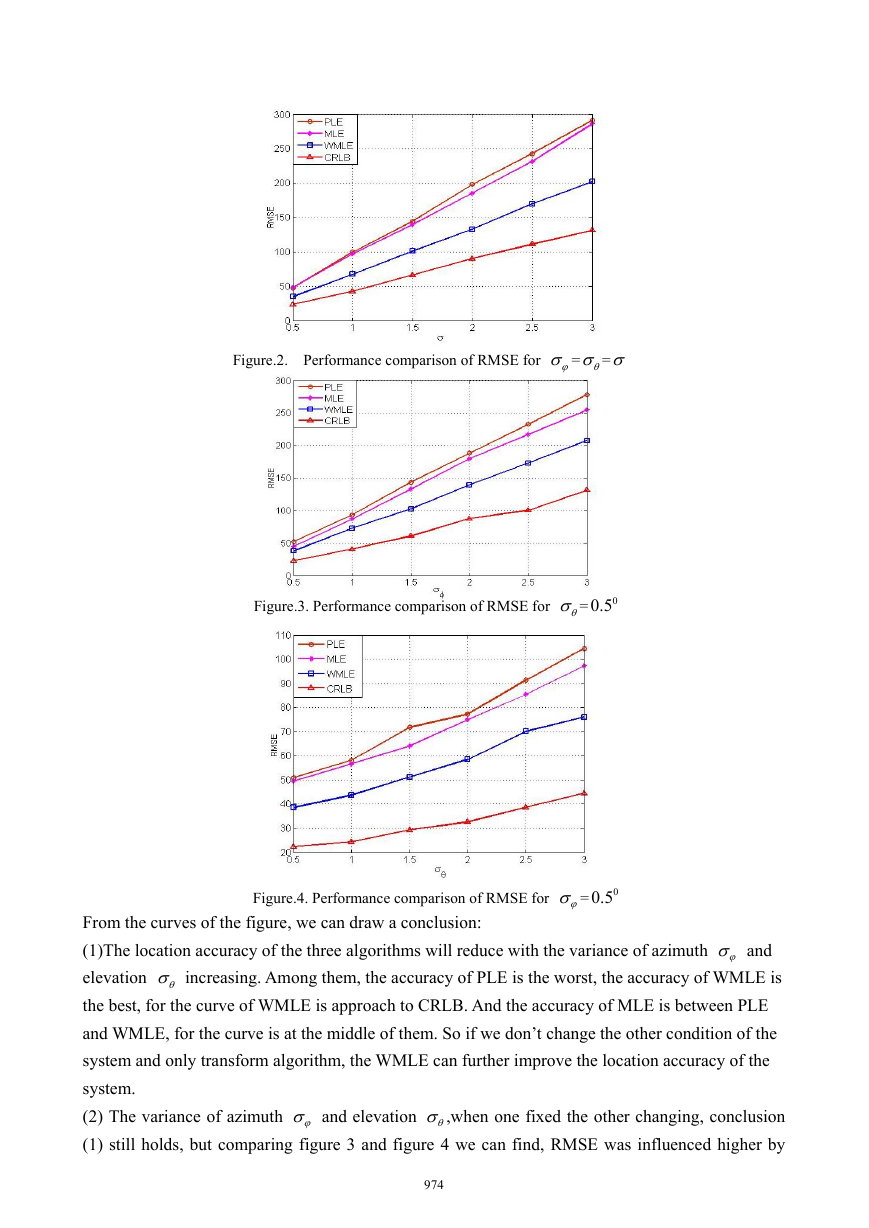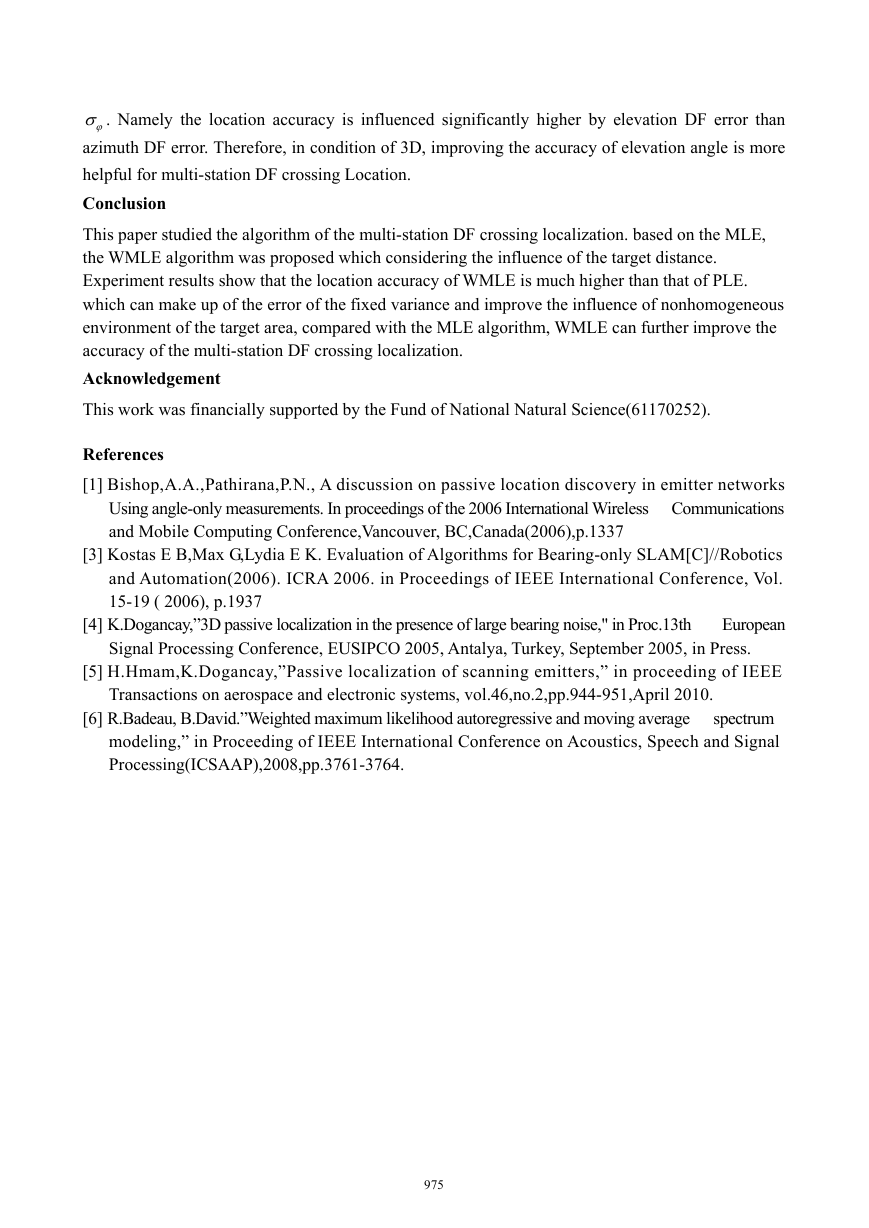Algorithm and Accuracy Analysis of Weighted Maximum Likelihood Estimation
in Multi-station DF Crossing Localization
Zong Junjun1, a *,Cui Xunxue2,b,Yang Hui3,c,Gao Bin4,d
1,2,,3,4New Star Research Institute of Applied Technology, Hefei, 230031,P.R.China
azjj_2008@163.com, bcuixx_2013@163.com, csanpedroman@163.com, d563321248@qq.com
Corresponding Author: Zong Junjun.Tel:18909699781. E-mail:zjj_2008@163.com
Keywords: passive localization; direction-finding (DF); crossing localization; weighted maximum
likelihood estimation (WMLE); error analysis
Abstract: In order to solve the non uniform environment of the target area influencing the variance
of DF error, the weighted maximum likelihood estimation (WMLE) algorithm was proposed. In this
algorithm, the effect of the target distance was introduced into MLE. we construct the weighted
vector to make up for the effect when the target distance increase the variance of the DF error
become worse. Theoretical analysis showed that the algorithm of WMLE could further improve the
accuracy of the multi-station DF crossing localization.
Passive acoustic localization has received good attention in the world and obtained considerable
development in the military fields, for its good concealment, strong confidentiality and less
susceptible to interference. Among its many location methods, multi-station DF crossing location is
one of the important. It is a kind of method, by using multi-station DF information to obtain the
location of target, also known as triangulation method. The location accuracy is mainly affected by
the DF’s accuracy, array’s quantity, base-station’s configuration, localization’s algorithm and other
factors, especially when the sensor’s device and array’s configuration was constrained, location
algorithm would become the main factors affecting the location accuracy.
Recently years, many mature localization algorithms have been formed, such as least squares
estimation (LSE), pseudo-linear estimation (PLE), maximum likelihood estimation (MLE). Among
them, the performance of MLE is excellent. When using the MLE to locate the sound point of the
burst, we usually assume the variance (σ) of DF error is unchanged. But actually, target region isn’t
an uniform environment, σ will be influenced by the target distance. Obviously, from the control
of estimation error, MLE isn’t an effective method. This article according to the point of the account
source, based on the view of Dogancay’s MLE, we construct the WMLE, namely, by setting the
weighted function to compensate for the effect of heterogeneous environment on DF error.
Location Principle
In figure 1, The station position is represented by
= , where
1,2,
T denotes matrix transpose. The true location of the stationary target is represented by
,
x y z
k
)T
,
n
=
S
k
k
k
)
(
,
(
k
4th International Conference on Computer, Mechatronics, Control and Electronic Engineering (ICCMCEE 2015) © 2015. The authors - Published by Atlantis Press971�
(
T
)
p
p
p
P
,
,
z
y
x
=
X
. We collect azimuth ( kθ ) and elevation ( kφ ) angle at each station. The unit of
measurement is radian. It is assumed that azimuth and elevation angles are independent of each
other, which satisfied with zero mean Gaussian noise, and their mean-square-deviation are denoted
as
kθσ and
kφσ .
Target (
,
x y z
,
p
p
)
p
z
1φ
1θ
x
y
(
station1
,
,
x y z
1
1
1
)
z
2φ
2θ
(
y
x
Nφ
y
station2
,
,
x y z
2
2
2
)
z
Nθ
Station n
,
x y z
,
n
n
n
(
x
)
Figure.1. 3-D AOA based source localization for noisy case
According to the relations between stations and emitter sources, we can get equation (1) and (2)
y
x
−
−
y
)k
x
k
θ
k
=
1
tan (
−
φ
k
=
1
tan (
−
(1)
p
2
z
)
x
k
−
+
z
(
k
y
)
−
y
k
p
2
)
(2)
(
x
p
−
)
)
(
)
=
J
(
ML p
(
T
e p W e p
Weighted Maximum Likelihood Estimation
According to the principle of maximum likelihood estimation, we can construct the maximum
likelihood cost function
1
−
Where W is a covariance matrix of the bearing noise and
expressed as
{
2
2
2
,
,
W diag
σ σ σ σ σ σ
θ θ
φ
1
2
n
)
(
,
e p
p
−
θ θ
φ φ
1
1
1
1
(3)
(
e p is the error vector, which can be
Therefore, the estimation value of the emitter source can be expressed as
2
2
2
,
θ
φ φ
1
2
n
(
,
p
θ θ
n
n
(4)
)
p
(5)
,
φ φ
n
n
,
=
)
,
−
,
−
}
(
,
)
−
=
p
(
(
)
)
,
,
ˆ
p
ML
=
arg min
p
J
(
p
)
ML
(6)
The maximum likelihood location estimator is an nonlinear equation, so it does not have a
closed-form solution and requires the use of a numerical search algorithm. The Gauss-Newton (GN)
972�
algorithm, which is a batch iterative minimization technique, is often employed to calculate the
MLE. The GN algorithm consists of
X
+ =
1
i
X
i
−
(
J W J
-1
T
i
i
1
−
)
1
−
J W e P (7)
T
i
i
(
)
Where
iJ is the 2N×3 Jacobian of
(
)
e p
−
−
−
i
i
i
i
0
0
J
i
( )
i
sin
−
−
ˆ
φ
n
ˆ
θ
1
ˆ
φ
1
ˆ
φ
1
( )
i
( )
i
( )
i
( )
i
( )
i
sin ( )sin ( )
i
ˆ
( )cos
i
θ
n
X S
(8)
ˆ
cos
φ
1
ˆ
d
1
i
ˆ
cos
φ
n
ˆ
d
in
ˆ
i
θ
1
X S
ˆ
sin
φ
1
ˆ
d
1
i
ˆ
sin
φ
n
ˆ
d
in
ˆ
sin ( )cos
i
θ
1
X S
=
Where ˆ
d =
ik
k th station.
coordinate of the target can be calculated by the PLE.
From the above GN iterative, we can find the variance of DF error of azimuth ϕσ and elevation
θσ is unchanging, but actually, DF error is influenced by the target distance, usually it will become
big with the increase of the distance. Here, we assume that the variance of DF error of azimuth and
elevation is σ when the distance is d , So we can draw
iσ corresponding to the target distance
id . The relationship can be expressed as
,denote as the distance between the i th emitter source and the
is a 2×1 vector containing the first two entries of
iX . The initial
(9)
2
cos
ˆ
d
1
i
ˆ
2
cos
θ
n
ˆ
d
in
(1: 2)
−
、 (1: 2)
ˆ
( )sin
i
θ
n
X S
X
(1: 2)
i
iX
(1: 2)
S
k
kS
( )
i
ˆ
φ
n
sin
( )
i
( )
i
−
i
−
i
−
n
n
σ
ϕ
ki
σ=
ϕ
k
kid
d
kid
d
(10)
σ
θ
ki
σ=
θ
k
The covariance matrix (W)of the DF error can be expressed as
,
2
,
σ σ σ
φ
2
2
θ
ni
2
φ
1
i
,
,
i
,
{
2
σ σ
θ
2
2
θ
1
i
,
i
=W
i
2
,
σ
φ
ni
diag
}
(11)
Simulation Experiment
Experiment Condition. Assuming the system is conformed by six base stations, which has uniform
linear array and located at the x axis from -3000 to 3000. And the area of target is assumed as:
axis x is ±3km, axis y is 1km~7km,axis z is ±0.5km. The variance σ of azimuth and
elevation is assumed as
Experiment result and Result analysis. Figure 2, figure 3 and Figure 4 are RMSE’s curve of 1000
Monte-Carlo experiment results of PLE, MLE , WMLE and CRLB. The unit of x axis is degree,
y axis is meter. In figure 2, the variance of azimuth ϕσ and elevation θσ are equal, they
00.5 to
changed from
03 .In figure 4,
03 at the same time. In figure 3,
03 .
, ϕσ changed from
00.5 、 01.0 、 01.5 、 02.0 、 02.5 、 03.0 .
, θσ changed from
00.5 to
00.5
θσ =
00.5 to
ϕσ =
00.5
973�
Figure.2. Performance comparison of RMSE for ϕσ = θσ =σ
Figure.3. Performance comparison of RMSE for θσ =
00.5
Figure.4. Performance comparison of RMSE for ϕσ =
00.5
From the curves of the figure, we can draw a conclusion:
(1)The location accuracy of the three algorithms will reduce with the variance of azimuth ϕσ and
elevation θσ increasing. Among them, the accuracy of PLE is the worst, the accuracy of WMLE is
the best, for the curve of WMLE is approach to CRLB. And the accuracy of MLE is between PLE
and WMLE, for the curve is at the middle of them. So if we don’t change the other condition of the
system and only transform algorithm, the WMLE can further improve the location accuracy of the
system.
(2) The variance of azimuth ϕσ and elevation θσ ,when one fixed the other changing, conclusion
(1) still holds, but comparing figure 3 and figure 4 we can find, RMSE was influenced higher by
974�
ϕσ . Namely the location accuracy is influenced significantly higher by elevation DF error than
azimuth DF error. Therefore, in condition of 3D, improving the accuracy of elevation angle is more
helpful for multi-station DF crossing Location.
Conclusion
This paper studied the algorithm of the multi-station DF crossing localization. based on the MLE,
the WMLE algorithm was proposed which considering the influence of the target distance.
Experiment results show that the location accuracy of WMLE is much higher than that of PLE.
which can make up of the error of the fixed variance and improve the influence of nonhomogeneous
environment of the target area, compared with the MLE algorithm, WMLE can further improve the
accuracy of the multi-station DF crossing localization.
Acknowledgement
This work was financially supported by the Fund of National Natural Science(61170252).
References
[1] Bishop,A.A.,Pathirana,P.N., A discussion on passive location discovery in emitter networks
Using angle-only measurements. In proceedings of the 2006 International Wireless Communications
and Mobile Computing Conference,Vancouver, BC,Canada(2006),p.1337
[3] Kostas E B,Max G,Lydia E K. Evaluation of Algorithms for Bearing-only SLAM[C]//Robotics
and Automation(2006). ICRA 2006. in Proceedings of IEEE International Conference, Vol.
15-19 ( 2006), p.1937
[4] K.Dogancay,”3D passive localization in the presence of large bearing noise," in Proc.13th European
Signal Processing Conference, EUSIPCO 2005, Antalya, Turkey, September 2005, in Press.
[5] H.Hmam,K.Dogancay,”Passive localization of scanning emitters,” in proceeding of IEEE
Transactions on aerospace and electronic systems, vol.46,no.2,pp.944-951,April 2010.
[6] R.Badeau, B.David.”Weighted maximum likelihood autoregressive and moving average spectrum
modeling,” in Proceeding of IEEE International Conference on Acoustics, Speech and Signal
Processing(ICSAAP),2008,pp.3761-3764.
975�










 2023年江西萍乡中考道德与法治真题及答案.doc
2023年江西萍乡中考道德与法治真题及答案.doc 2012年重庆南川中考生物真题及答案.doc
2012年重庆南川中考生物真题及答案.doc 2013年江西师范大学地理学综合及文艺理论基础考研真题.doc
2013年江西师范大学地理学综合及文艺理论基础考研真题.doc 2020年四川甘孜小升初语文真题及答案I卷.doc
2020年四川甘孜小升初语文真题及答案I卷.doc 2020年注册岩土工程师专业基础考试真题及答案.doc
2020年注册岩土工程师专业基础考试真题及答案.doc 2023-2024学年福建省厦门市九年级上学期数学月考试题及答案.doc
2023-2024学年福建省厦门市九年级上学期数学月考试题及答案.doc 2021-2022学年辽宁省沈阳市大东区九年级上学期语文期末试题及答案.doc
2021-2022学年辽宁省沈阳市大东区九年级上学期语文期末试题及答案.doc 2022-2023学年北京东城区初三第一学期物理期末试卷及答案.doc
2022-2023学年北京东城区初三第一学期物理期末试卷及答案.doc 2018上半年江西教师资格初中地理学科知识与教学能力真题及答案.doc
2018上半年江西教师资格初中地理学科知识与教学能力真题及答案.doc 2012年河北国家公务员申论考试真题及答案-省级.doc
2012年河北国家公务员申论考试真题及答案-省级.doc 2020-2021学年江苏省扬州市江都区邵樊片九年级上学期数学第一次质量检测试题及答案.doc
2020-2021学年江苏省扬州市江都区邵樊片九年级上学期数学第一次质量检测试题及答案.doc 2022下半年黑龙江教师资格证中学综合素质真题及答案.doc
2022下半年黑龙江教师资格证中学综合素质真题及答案.doc